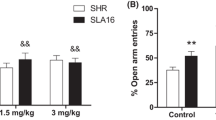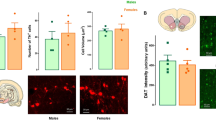Abstract
The role of genotype in the effects of selective D1 and D2 dopamine agonists and antagonists on behavioural despair (Porsolt's test) was studied. Mice of nine inbred strains showed significant interstrain differences in duration of immobility. The influence of dopaminergic drugs was assessed in six strains characterized by different levels of swimming activity. SKF 38393 (10 mg/kg), an agonist at D1 dopamine receptors, increased swimming activity, while the D1 antagonist SCH 23390 (0.2 and 0.5 mg/kg) reduced it, the effects being genotype dependent. The involvement of D2 dopamine receptors in the regulation of mouse behaviour in the forced swimming test was not so evident; the D2 agonist bromocriptine (10 mg/kg) produced no significant effect. The D2 agonist quinpirole (2.5 mg/kg) increased immobility in the majority of the mouse strains studied, while in CBA mice it resulted in a marked reduction of immobility. The D2 antagonist sulpiride (20 mg/kg) decreased immobility and increased active swimming only in two strains. The present results suggest a different role for D1 and D2 dopamine receptors in the regulation of swimming in the mouse.
Similar content being viewed by others
References
Arnt J, Hyttel J, Perregard J (1987) Dopamine D-1 receptor agonist combined with the selective D-2 agonist quinpirole facilitate the expression of oral stereotyped behaviour in rats. Eur J Pharmacol 133:137–145
Borsini F, Meli A (1988) Is the forced swimming test a suitable model for revealing antidepressant activity? Psychopharmacology 94:147–160
Borsini F, Volterra G, Meli A (1986) Does the behavioral “despair” test measure “despair”? Physiol Behav 38:366–385
Cabib S, Puglisi-Allegra S, Oliverio A (1985) A genetic analysis of stereotypy in the mouse: dopaminergic plasticity following chronic stress. Behav Neural Biol 44:239–248
Christensen AV, Arnt J, Hyttel J, Larsen J-J, Svendsen O (1984) Pharmacological effects of a specific dopamine D-1 antagonist SCH 23390 in comparison with neuroleptics. Life Sci 34:1529–1540
Hilakivi LA, Lister RG (1990) Correlations between behaviour of mice in Porsolt's swim test and in tests of anxiety, locomotion and exploration. Behav Neural Biol 53:153–159
Hoffman DC, Beninger RJ (1985) The D-1 dopamine receptor antagonist, SCH 23390 reduces locomotor activity and rearing in rats. Pharmacol Biochem Behav 22:341–342
Hyttel J (1983) SCH 23390 — the first selective dopamine D-1 antagonist. Eur J Pharmacol 91:153–154
Jackson DM, Jenkins OF, Ross SB (1988) The motor effects of bromocriptine — a review. Psychopharmacology 95:433–446
Jackson DM, Ross SB, Edwards SR (1989) Dopamine D2 agonist induced behavioural depression is reversed by dopamine D1 agonists. J Neural Transm 75:213–220
Klemm WR, Block H (1988) D-1 and D-2 receptor blockade have additive cataleptic effects in mice, but receptor effects may interact in opposite ways. Pharmacol Biochem Behav 29:223–230
Klimek V, Nielsen M, Maj J (1985) Repeated treatment with imipramine decresed the number of [3H]piflutixol binding sites in the rat striatum. Eur J Pharmacol 109:131–132
Meller E, Kuga S, Friedhoff AY, Goldstein M (1985) Selective D2 dopamine receptor agonists prevent catalepsy induced by SCH 23390, a selective D1 antagonist. Life Sci 36:1857–1864
Mereu G, Casu M, Gessa GL (1983) (-)-Sulpiride activates the firing rate and tyrosine hydroxylase activity of dopaminergic neurons in unanesthesized rats. Brain Res 264:105–110
Morelli M, Fenu S, Di Chiara C (1986) Behavioral expression of of D-1 receptor supersensitivity depends on previous stimulation of D-2 receptors. Life Sci 40:245–251
Nishimura H, Tsuda A, Oguchi M, Yda Y, Tanaka M (1988) Is immobility of rats of the forced swim test “behavioral despair” Physiol Behav 42:93–95
Nomura S, Shimezu J, Kinjo M, Kametani H, Nakazawa T (1982) A new behavioral test for antidepressant drugs. Eur J Pharmacol 83:171–175
Plaznik A, Danysz W, Kostowski W (1985) Mesolimbic noradrenaline but not dopamine is responsible for organization of rat behaviour in the forced swim test and anti-immobilizing effect of desimipramine. Pol J Pharmacol Pharm 37:347–357
Porsolt RD, Anton G, Jalfre M (1978a) Behavioral despair in rats: a new model sensitive to antidepressant treatments. Eur J Pharmacol 47:379–391
Porsolt RD, Berin A, Jalfre M (1978b) “Behavioural despair” in rats and mice: strain differences and the effects of imipramine. Eur J Pharmacol 51:291–294
Puglisi-Allegra S, Cabib S (1988) The D2 dopamine receptor agonist LY 171555 induces catalepsy in the mouse. Pharmacol Biochem Behav 30:765–768
Seale TW, McLanahan K, Johnson P, Carney JM, Rennert OM (1984) Systematic comparison of apomorphine-induced behavioural changes in two mouse strains with inherited differences in brain dopamine receptors. Pharmacol Biochem Behav 21:237–244
Serra G, Collu M, M'Aquila P, Pani L, Gessa G (1988) Are D1 dopamine receptor agonists potential antidepressants? Pharmacol Res Commun 12:1121–1122
Severson JA, Randall PK, Finch CE (1981) Genotypic influences on striatal dopaminergic regulation in mice. Brain Res 210:201–215
Skrinskaya JA, Nikulina EM (1988) Genotypic differences in brain dopamine metabolism and dopamine-dependent forms of behaviour in the mouse. Genetika 24:1321–1324 (in Russian)
Steru L, Chermat R, Thierry B, Mico J-A, Lenegre A, Stern M, Simon P, Porsolt R (1987) The automated tail suspension test: a computerized device which differentiates psychotropic drugs. Prog Neuropsychopharmacol Biol Psychiatry 11:659–671
Stoof JC, Kebabian JW (1984) Two dopamine receptors: biochemistry, physiology and pharmacology. Life Sci 35:2281–2296
Trullas R, Jackson B, Skolnick P (1989) Genetic differences in a tail suspension test for evaluating antidepressant activity Psychopharmacology 99:287–288
Vetulani J, Sansone M, Oliverio A (1982) Analysis of the difference in the behavioral effects of apomorphine in C57BL/6 and DBA/2 mice. Pharmacol Biochem Behav 17:967–971
Willner P (1984) The validity of animal models of depression. Psychopharmacology 83:1–16
Author information
Authors and Affiliations
Rights and permissions
About this article
Cite this article
Nikulina, E.M., Skrinskaya, J.A. & Popova, N.K. Role of genotype and dopamine receptors in behaviour of inbred mice in a forced swimming test. Psychopharmacology 105, 525–529 (1991). https://doi.org/10.1007/BF02244374
Received:
Revised:
Issue Date:
DOI: https://doi.org/10.1007/BF02244374




